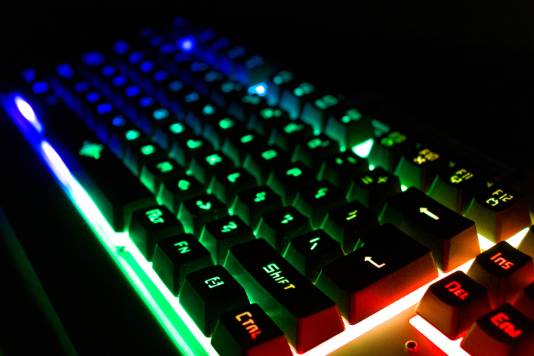A keyboard is just a keyboard, isn’t it? It sits right there in front of your monitor and it’s pretty much the same as all of the rest, isn’t it? Well, hold it right there! No, it isn’t. They are NOT all the same. There are hundreds and hundreds of different keyboards out there – some mechanical, some membrane. We’re going to take a look at the differences between mechanical and membrane keyboards – and why mechanical is a benefit to gamers and what to look out for when it comes to shopping for a mechanical keyboard.
If you spend eight hours a day working, and let’s say half of that typing, for a five-day week and 48-week working year, that’s almost 1,000 hours of typing on your keyboard every year! Despite that sobering figure, most of us just use whatever keyboard arrives with the computer.
So, what are mechanical keyboards?
A mechanical keyboard uses a metal component to provide mechanical resistance on the switch (unlike a dome or membrane keyboard which usually use rubber or plastic). You will normally find this resistance to be a spring, but other methods are sometimes used too. This is what gives the mechanical keyboard some of its firmer, and adaptable, resistance.

Mechanical key switches give far stronger feedback as you type. Users will feel this in the form of a soft bump, an audible click, and a smooth bottom out to the keyboard’s base.
These keyboards feel far more satisfying than a rubber dome / membrane keyboard. They can be more precise and, crucially, last for a very long time.
Pre-2000s, almost every computer keyboard used individual, mechanical switches under every key. However those keyboards were expensive to manufacture, so as technology advanced, the cheaper monoblock dome keyboards came into play.
In recent years mechanical keyboards have enjoyed a renaissance, and they are proving really popular since being adopted by the gaming community.
Buy Mechanical Keyboards from Ebuyer- lots to choose from.
Keyboards, the basics.
On your keyboard, the device that translates your key press into an input your PC recognises is called a switch. These switches work by completing an electrical circuit when you press the key.
Mechanical keyboards have an advantage over their rivals due to the quality, resistance and adaptability of these switches. Most keyboards, like the ones you get bundled with desktop computers when you buy them, or likely at work, use what’s known as a dome or membrane switch (these terms are sometimes interchangeable but do differ slightly, but we’re not going into it today). This is where each of your keys sits on top of a rubber dome or rubber membrane which depresses when you hit a key to type.
This format of keyboard became popular in the late-1990s with the rise of cheap(er) home computing. Dome switches are lightweight and cheap to produce, but after that, have very few benefits. In fact, the thin rubber membrane or dome used in these switches degrades quickly, giving the keyboard a frustrating spongy touch when depressed after too much use.
Common mechanical switches
Ok, so back to the Cherry MX range briefly. Their most common four switches are MX Red, Black, Blue, and Brown. These are usually the switches people start out using due to their distinct style. Kailh and Razer have a similar range, with a few colour variations (the addition of orange and yellow)… These can be further split out into ‘Linear’, ‘Tactile’ and ‘Clicky’.

Key switches — especially Cherry MX and variants — are typically labeled by colour; for example, ‘Blue’ or ‘Brown’. Different colours are attributed to different switch types; most typically, a switch that is either linear, tactile, or clicky.
Whilst trying to describe the way a key switch feels in words may well seem like an exercise in futility, we’re going to attempt just that regardless.
A clicky switch is a bit more simple to communicate. It has a similar kind of bump at the top like a tactile switch but makes an audible click on actuation (or both directions in the case of Kailh Box Whites, for example).
Linear switches have the simplest operation, moving straight up and down without any additional feedback or loud clicking. Conversely Tactile switches provide feedback as the key depresses. This can be anything from a noticeable bump, which lets you know that your key press has been registered, or a click noise.
The point of all this is to give the user the option to choose how they like to use their keyboard. This is particularly important in gaming where different scenarios require different keystrokes.
You may not want a firm key with a click if you are constantly bashing keys (Kailh Mechanical RED). Conversely for something like an RTS or typing, the sound of a key click may help you concentrate (Cherry MX BLUE).
How to buy a Mechanical Keyboard
For the rest of you, if you’re still confused and are still looking to buy a keyboard, go out and test some of the different styles. It’s really the best way to find what suits you, especially with the wide array of different formats. It really is down to comfort, cost and (for gamers) the style of play.
To note… When choosing a mechanical keyboard you‘ll likely be given a name like Element Gaming Beryllium Mechanical RED. This means your keyboard has the Kailh Mechanical RED switch format, compared to something like Corsair Gaming STRAFE Cherry MX Brown, which is of course Cherry MX Brown.
Advantages of Mechanical Keyboards
Ok so we’ve run through the basics of mechanical keyboards, but what are the actual advantages?
Precision and Speed. Many mechanical keyboards tend to be easier to use in terms of speed and exertion. Most mechanical switches only need to be pressed halfway before registering a keystroke. This is known as the actuation point (as an example, if it normally takes other types of keyboards 4mm to actuate, it only takes mechanical keyboard keys about 2 mm to actuate). A lower actuation points means less work for your fingers and crucially a quicker response time.
Versatility:
As mentioned above, mechanical keyboards come in a number of different flavours depending on your typing style. From a sharp satisfying click to a heavy weighted key, mechanical keyboards can be utilised to help with unorthodox typing style and of course gamers.

Aesthetics:
Manufacturers love designing sharp looking keyboards – and frankly the mechanical versions always look the best. With their isolated keys and quirky design mechanical keyboards always look great.
Build Quality:
Gamers spend a lot of time hammering their keyboard, so your keys need to be able to stand up to all that work. Mechanical keyboards are designed with hard work in mind. Unlike membrane keyboards, their mechanical counterparts can take far more wear and tear due to the design and materials used in the switches.

Keyboard Sizes
A keyboard layout is most typically defined first and foremost by its size. Going smallest to largest:
40% – Diminutive layout where many keys are doubled up, requiring an additional key to be pressed alongside the desired one. Unless you have a specific reason to have one, we couldn’t really recommend this layout for practical purposes;
60% – Typically a normal key layout minus a dedicated arrow key cluster, home/end/page up and page down or function keys;
65% – Compact like a 60% but usually incorporating at least an arrow cluster;
75% – Usually brings in a distinct function row;
TKL – The ‘Ten Key-Less’ is a more conventional layout, think of a ‘normal’ keyboard minus the number pad section;
Full size – The typical keyboard layout complete with function keys, number pad, and arrow cluster.
Buy Mechanical Keyboards from Ebuyer- lots to choose from.
Ergonomic Keyboards
Some people stumble into mechanical keyboards in the search for a more ergonomic keyboard. One area where mechanical keyboards can honestly claim some bragging rights is in the variety of ergonomic boards and layouts on offer.
For example, consider the Ergodox EZ. This keyboard is completely split (albeit apart from a wire connecting the two halves) and enjoys the increasingly popular feature of a ‘hotswap’ printed circuit board. This means that you can easily swap out one lot of mechanical switches for another depending upon your preference. That’s certainly a good thing.
It’s common to start with mechanical keyboards favouring one switch type and then as time goes on you grow to prefer another. This way, you don’t have to buy a whole new keyboard; just replace the switches. The Ergodox EZ is also entirely programmable meaning you can adjust any key to do whatever you like. The layout choices are genuinely almost infinite.

Keycaps
One of the biggest draws of a mechanical keyboard is that you can easily swap out the keycaps for a different set. As we discussed in the section on key switch types, the most popular switch type, when it comes to keycaps, is ‘Cherry MX’ compatible. Therefore, by far the most ubiquitous keycap mount is Cherry MX style.
However, within the realms of the MX mount connection type there are a great many options. There are choices in terms of materials used, key profiles, and legend marking method. Let’s look at each of those.
Popular key profile types:
SA
These are quite high keys and enjoy a sculpted shape down the rows (if you were looking at the keys side on).
DSA
DSA are a lower key and although they have a slightly curved top to each key like the SA, they do not have a sculpted shape down the rows.
If you are just starting with a mechanical keyboard, I’m not sure it’s useful to worry too much about the key profile. However, it might be interesting to consider the kind of options available.
Signature Plastics, one of the largest and most popular producers of custom keycaps has a page dedicated to the different profiles they offer with PDF specifications to boot.
You might also see row numbers mentioned; this has most relevance if you are looking at a sculpted set of keys.
Row refers to the location of the keys on the keyboard and is most important when ordering a sculptured keycap family. On a standard QWERTY board, the “number” row is row 1; the “Q” row is row 2; the “A” row is row 3; the “Z” row and the space bar row are row 4; the upper “function key” row can be either row 5 style or row 1 style.

Summary
Let us try and distill everything we’ve been through here.
Firstly, mechanical keyboards offer a level of tactility in keyboards that is simply not achievable elsewhere with other types of ‘board. Furthermore, with many keyboards offering programmability, it means yours no longer needs to adhere to the standard layout you’ve previously been used to. Each key can do whatever you want it to!
But don’t think mechanical keyboards are just for gamers. They are fantastic for most computer users. If your job involves a lot of keyboard work than you’ll enjoy a mechanical keyboard as they make typing so much easier.



